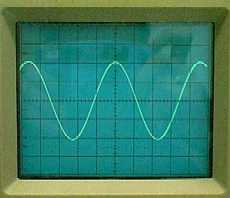

Oscilloscope Screen: The oscilloscope's screen is a CRT (cathode ray tube) display device that works much like a television.
CRT Operation: Electricity is passed through a piece of metal that gives up electrons upon heating. This metal is negatively charged and is called the cathode. Those electrons are then accelerated away from the negatively charged cathode (as electrons are negative and like charged particles repel) and toward the positively charged screen surface called the anode. While the electrons are moving toward the screen they pass through an area of four opposing metal plates or two metal plates and an electromagnet with varying charge or polarity that push the electrons in certain directions depending on the charge or polarity. The input signal from either CH 1 or CH 2 supplies the electricity to charge the plates or change the magnetic polarity such that the electron beam moves in a particular motion as to emulate the waveform of the input signal (like in the picture above).
Finally, the electrons hit the positively charged surface of the screen which is coated in phosphorous so that it glows when it is struck by a high energy electron. The glowing of the phosphorous is what we see.
Graticule: The screen area that we see when we look at an oscilloscope is covered by 80 squares. These squares make up what is called the graticule. The graticule is important for measuring amplitudes and phases and frequencies etc. of input signals. The standard size of the squares (divisions) in the graticule is 1cm2.